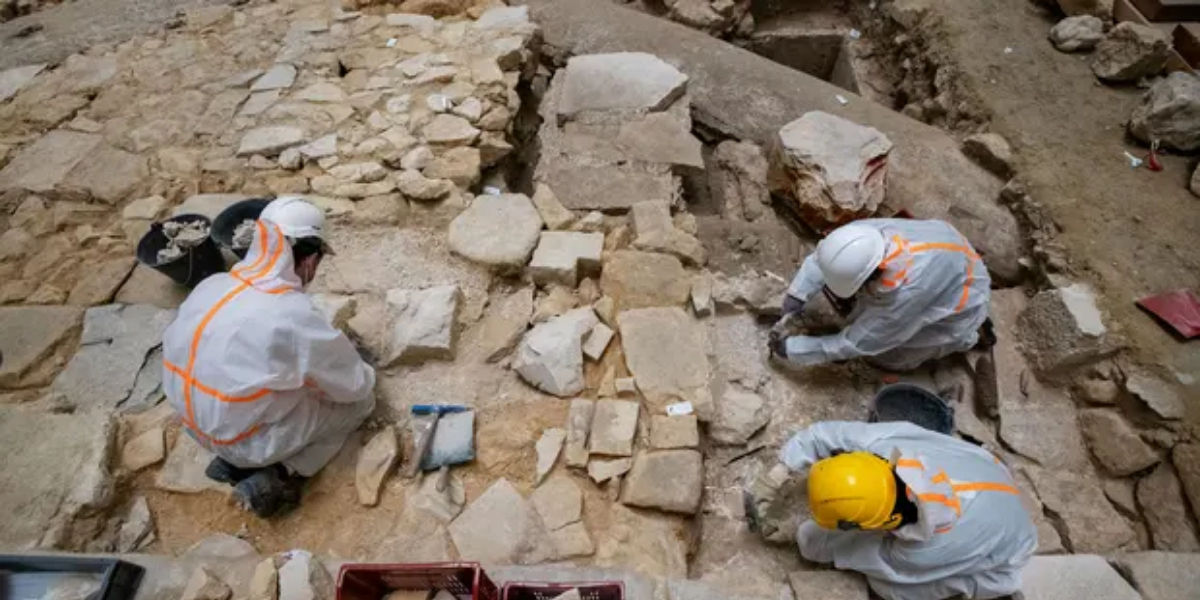Archaeological digs under Notre Dame Cathedral have found a priceless cache of 13th-century statues, sculptures, tombs, and fragments of a rood screen.
In the core of the burned-out structure, under the transept crossing, were seven mediaeval burials and a body-shaped lead sarcophagus.
French specialists have characterised the finding as “extraordinary and emotional”.
“We unearthed all these treasures barely 10-15cm beneath the floor slabs. It came as a total surprise. It was amazing to see the historical evidence that had been unearthed,” said Christophe Besnier, director of the dig’s scientific team.
I couldn’t stop crying. Suddenly we had several hundred pieces from minute bits to enormous blocks comprising carved hands, feet, faces, architectural ornaments and vegetation. Color remained on a few of the pieces.”
The find was made public on Thursday by Inrap, France’s national archaeological institution. A team from the institution was brought in to conduct out a “preventive dig” beneath a portion of the cathedral floor between February and April before a 100ft-high 600-tonne scaffold was erected to repair the monument’s spire.

Up until this point, just a few fragments of Notre Dame’s original rood screen — an elegant wall between the nave and chancel — survived. Some of them are in the cathedral storage chambers, while others are on exhibit at the Louvre. During the Counter-Reformation in the 16th and 17th centuries, most were removed from Catholic churches. The remainder of the Notre Dame rood seems to have been meticulously buried beneath the cathedral floor during the building’s renovation by Eugène Viollet-le-Duc – who erected the spire – in the mid-19th century.
One of the most astonishing objects was an entire sculpture of the head of a man, thought to be a likeness of Jesus, sculpted from stone. A memorial in the Gothic style may be seen on another block of the rood screen, which is said to date back to the 13th century.
This is how it worked for the Inrap team: They were given a very short deadline and only a small area to dig in. 850-year-old Notre Dame Cathedral was almost completely destroyed by fire in April 2019. President Emmanuel Macron promised to have it rebuilt and open for mass in five years.
General Jean-Louis Georgelin, who was chosen to lead the restoration project, said last September that the safety of the cathedral structure had been confirmed, which meant that the restoration and reconstruction of the parts destroyed by fire could start. There will be services and public visits in 2024 as promised, he said.

Several more slabs of the rood screen were found under the floor, but they were outside the boundaries of the dig. “We know they’re there and won’t be hurt.” It’s possible we’ll find them at a later time, he said.
Another thing that was discovered during the excavation was a network of masonry pipes that were installed under the floor in the 1800s.
Experts think the lead sarcophagus might be the body of a high church official who died in the 14th century. A camera that was inserted into the coffin had found plant remains under the head of the deceased, along with hair and pieces of cloth, but there was no plate that identified the person inside.
A sarcophagus with a human body inside is not an archaeological object, says the president of Inrap. Dominique Garcia says more tests, like DNA tests, will be done. When we look at the sarcophagus and the body inside, we must do so with respect.
Afterward, he said that no decision had been made about where the body would be buried again. “It’s too soon to say.” Somewhere in the cathedral, it’s possible that it will be put back in place.
[embedpost slug=”/massive-policy-failure/”]


















